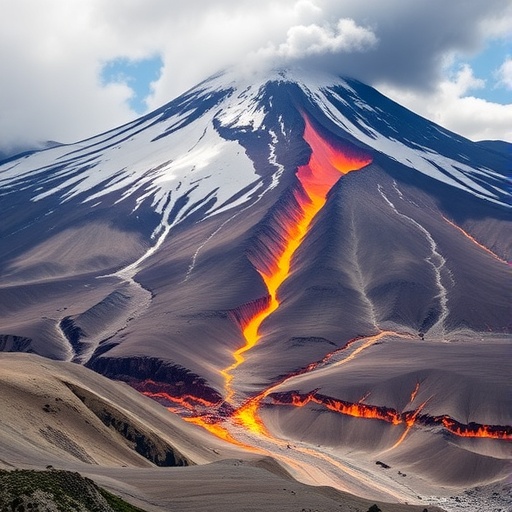In a groundbreaking study, researchers have employed tremor signals to unravel the complex structure and dynamics of the magmatic plumbing system beneath Oldoinyo Lengai, a stratovolcano located in Tanzania. This pioneering work by Reiss, Caudron, Hering, and their colleagues offers profound insights into volcanic behavior and has significant implications for understanding the potential hazards posed by one of the world’s most active volcanoes. The Oldoinyo Lengai volcano, unique in its natrocarbonatite lava composition, serves as an invaluable case study for deciphering magmatic processes, particularly in areas with limited pre-existing data.
Tremor signals generated by volcanic activity are a vital tool in modern volcanology. They can provide real-time information about the behavior of magma beneath the Earth’s surface. In their research, the team utilized advanced seismic monitoring techniques to capture tremor signals emanating from Oldoinyo Lengai. This allowed the researchers to interpret the data not merely as disturbances but as a unique language spoken by the volcano itself. The analysis of these signals revealed a range of details about the nature and movement of magma, which is crucial for predicting future volcanic eruptions.
One of the key findings of the study is the identification of a well-defined magmatic plumbing system beneath Oldoinyo Lengai. This system acts as a conduit for magma, allowing it to rise to the surface during eruptions. By studying the characteristics of the tremor signals, the researchers were able to map out the structure of this plumbing network, gaining insights into its size, distribution, and the dynamics of magma movement within it. This is particularly important because understanding the layout of such networks is essential for assessing volcanic hazards.
In addition to mapping the plumbing system, the researchers explored the dynamic processes that occur within it. They observed that the movement of magma is not a simple, linear process. Instead, it is characterized by complex interactions and fluctuations. These fluctuations can influence when and how volcanic eruptions occur. The study indicates that by continuously monitoring tremor signals, scientists may be able to anticipate changes in volcanic behavior that could precede eruptions, thereby enhancing the safety of communities located near active volcanoes.
Moreover, this research exemplifies the application of interdisciplinary approaches in volcanology. By integrating seismology with geophysical modeling, the team developed a comprehensive understanding of the magmatic processes at work beneath Oldoinyo Lengai. This holistic methodology is becoming more prevalent in geological studies, ensuring that researchers are equipped with a diverse toolkit to tackle the complexities of the Earth’s interior.
An interesting aspect highlighted in the study is the historical context of Oldoinyo Lengai eruptions. The volcano has exhibited a series of unique eruptive phases characterized by varying styles and intensities. Some eruptions have produced spectacular natrocarbonatite lava flows, while others have been marked by explosive activity. Understanding the magmatic plumbing system’s dynamics provides essential context for these eruptive behaviors. The researchers hypothesize that insights gathered from tremor patterns may also shed light on past eruptions, offering valuable lessons for future volcanic monitoring and risk assessment.
As the world grapples with the consequences of climate change and increasing natural disasters, the importance of this research cannot be overstated. Improved volcanic monitoring capabilities can play a crucial role in disaster preparedness and mitigation. The data and knowledge gained through studies such as this one contribute to a global database that can aid in assessing volcanic risk worldwide. The researchers’ findings will help policymakers and emergency managers better prepare for potential volcanic eruptions, ultimately saving lives and protecting communities.
Collaboration between scientists, local governments, and communities is essential in implementing the findings from this study. By establishing monitoring stations and ensuring timely dissemination of information, it is possible to create comprehensive plans for volcanic crisis management. The successful integration of science and community engagement is vital for effective disaster response, demonstrating a model that can be replicated in other volcanic regions around the globe.
This research has also sparked interest in the broader volcanological community. Scientists from various disciplines, including geochemistry and geology, are now eager to replicate similar studies at other volcanoes. The methodologies refined in this study can serve as templates for future research endeavors, potentially leading to significant advances in our understanding of volcanic systems. Given the unique nature of Oldoinyo Lengai, comparisons with other volcanoes can yield insights into commonalities and differences in magmatic processes, enriching the field of volcanology.
Furthermore, the implications of this research extend beyond volcanic activity. Understanding magmatic systems can provide insights into geothermal energy potentials and mineral resources associated with volcanic regions. As the world moves towards sustainable energy solutions, leveraging the knowledge gained from studying volcanoes could lead to innovative approaches in harnessing geothermal energy, benefiting both science and society.
In conclusion, the study of tremor signals at Oldoinyo Lengai marks a significant advancement in the field of volcanology. By revealing the intricate details of the magmatic plumbing system, this research paves the way for more effective monitoring and understanding of volcanic behavior. The interdisciplinary approach employed by the researchers showcases the potential for richer insights when various scientific domains collaborate. As we move forward, the lessons learned from this study will foster an era of enhanced volcanic risk assessment and management, ultimately contributing to a safer future for communities living in the shadow of these majestic natural wonders.
Subject of Research: Oldoinyo Lengai magmatic plumbing system
Article Title: Tremor signals reveal the structure and dynamics of the Oldoinyo Lengai magmatic plumbing system
Article References:
Reiss, M.C., Caudron, C., Hering, P. et al. Tremor signals reveal the structure and dynamics of the Oldoinyo Lengai magmatic plumbing system. Commun Earth Environ 6, 781 (2025). https://doi.org/10.1038/s43247-025-02804-1
Image Credits: AI Generated
DOI: 10.1038/s43247-025-02804-1
Keywords: Volcanology, tremor signals, magmatic plumbing system, Oldoinyo Lengai, volcanic risks, seismic monitoring, geothermal energy.




